Understanding Inflation
Inflation is a fundamental economic concept, indicating the overall increase in prices and a corresponding fall in the purchasing power of money. If prices rise, each unit of currency buys fewer goods and services. This phenomenon affects economies worldwide and plays a critical role in shaping monetary policies and economic strategies.
Inflation is measured through various indices, with the Consumer Price Index (CPI) and the Producer Price Index (PPI) being among the most common. These indices track changes in prices for a basket of goods and services over time, providing valuable insights into inflation trends. Several elements contribute to inflation, including supply chain disruptions, changes in consumer demand, and adjustments in monetary policy by central banks. Supply issues—such as those experienced globally during the COVID-19 pandemic—can constrain the availability of goods, leading to price hikes. Demand fluctuations, conversely, may stem from shifts in consumer preferences or changes in income levels.
The Impact of Inflation on Investments
Inflation exerts a profound effect on investments, making it a critical factor for investors to consider. As inflation erodes purchasing power, it can diminish the real value of investment returns. For instance, if an investment yields a nominal return of 5% but inflation is running at 3%, the real return is only 2%. Hence, investors must aim for returns that outpace inflation to preserve their purchasing power.
Moreover, inflation impacts different types of investments variably. Fixed-income securities like bonds are particularly vulnerable as their fixed interest payments lose value in an inflationary environment. Conversely, other investments might fare better.
Asset Classes That Outpace Inflation
Certain asset classes are better equipped to handle inflationary pressures and even thrive under such conditions, providing investors with opportunities to protect and grow their wealth.
Stocks: Equities have historically been able to outpace inflation over the long haul. Companies often increase prices to counteract higher input costs, preserving or even enhancing their profitability during inflationary periods. This ability to pass on costs to consumers makes stocks an attractive option for long-term growth despite inflation.
Real Estate: Real estate is another favored hedge against inflation. Rising inflation often translates into higher property values and rental incomes. Additionally, real estate investments can offer continued cash flow and potential appreciation over time, making them a strategic choice for investors looking to counter inflation’s effects.
Commodities: Assets like gold, silver, and oil can act as a store of value when inflation is on the rise. These tangible commodities often appreciate as the cost of goods increases, providing a buffer against dwindling currency value.
Inflation-Protected Securities: Instruments like Treasury Inflation-Protected Securities (TIPS) are designed to shield investors from inflation. The principal value of these securities adjusts with inflation, offering a stable return even when prices rise.
Investment Strategies in an Inflationary Environment
Developing a robust investment strategy becomes essential in the face of inflation. There are several tactics investors can employ to navigate these uncertain waters effectively.
Diversification: Diversifying investments across different asset classes, industries, and geographies helps spread risk. By not putting all your eggs in one basket, you can protect against specific inflation-related impacts that might affect one section of the market more than others.
Long-Term Focus: Maintaining a long-term investment perspective helps investors look beyond short-lived inflationary spikes. Over time, markets tend to correct, and businesses adapt to changing economic conditions, potentially leading to healthy returns.
Regular Portfolio Review: Continuously assessing and rebalancing a portfolio ensures that it remains aligned with your risk tolerance, financial goals, and changing economic landscapes. By reviewing your investment performance periodically, you can make informed decisions and adjust your holdings in response to inflationary trends.
Another consideration is the role of interest rates, which central banks might adjust in an attempt to control inflation. When rates are low, borrowing costs decrease, and it may spur economic activity but could also fuel inflation. Conversely, high rates could deter spending and investment, slowing economic growth but potentially reducing inflationary pressures.
Conclusion
In conclusion, inflation is an inexorable economic force with far-reaching implications for both economies and investors. Understanding the nature of inflation and its impact on various investment vehicles is crucial for navigating the financial landscape effectively. By strategically selecting assets that have the potential to outpace inflation and employing well-rounded investment strategies, investors can not only preserve their purchasing power but ideally enhance it over time. For those seeking more personalized advice, consulting financial advisors or referring to trusted financial resources such as Investor.gov or Morningstar can provide further valuable insights. These resources offer a comprehensive view of market conditions and can guide the decision-making process in an inflationary environment.
This article was last updated on: August 21, 2025








